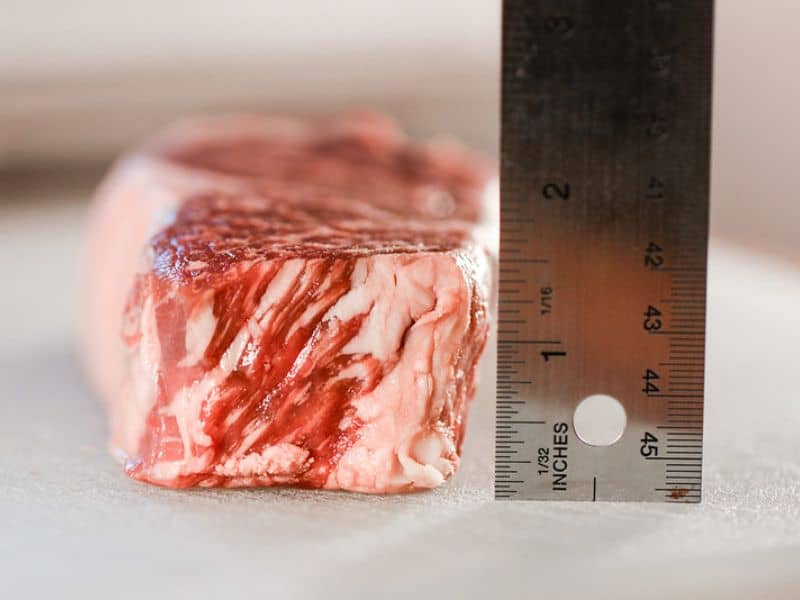The best thickness for steak is 1 to 2 inches. That’s what most top chefs and culinary experts recommend, and it’s a good number to keep in mind. The optimal thickness for steaks is 1.5 inches, but you can use this guideline for any type of steak or even a roast if you want to cook it evenly throughout.
Some people don’t realize that not all cuts of beef grow to that thickness; good examples are skirt steak and flat iron steak. Butchers often cut steaks to whatever thickness is most popular, which might vary depending on the beef primal being used and customer demand.
Does the Thickness of the Steak Actually Matter?
You’ve probably heard that the thickness of a steak is important.
But what does that mean, exactly?
You can see for yourself how much thicker a steak is by looking at its weight. A 1-inch thick ribeye will weigh more than a 1-inch thick filet mignon.
But how much more? And why should it matter?
Well, it’s all about cooking time, taste, and texture. The thinner the steak, the quicker it will cook—and the less time you have to wait for it to be ready to eat! Thinner steaks are also more tender and juicy than thicker ones. They’re perfect for grilling or pan-searing because they won’t dry out as easily as thicker cuts might do.
On top of all this, markets aim to make a profit by cutting thick steaks in half and selling them as two medium-sized cuts at twice the price of one single large cut. But since most people don’t know how thick a steak should be in order to be cooked properly (we’ll get into specifics later on), they often lose out when they buy these cheaper cuts because they end up undercooked or overcooked
So, how thick of a steak is ideal? What you’re waiting for is up next.
Best Thickness for Steak
The ideal thickness for a steak is 1.5 inches.
It’s not only the most common recommendation among chefs and meat specialists, it’s also the best size for your steak to cook evenly throughout.
The first reason is that it gives you the best chance of getting your preferred degree of doneness—you can easily get your steak cooked to medium-rare in this thickness (130 degrees Fahrenheit).
The second reason is that because this chunk of meat is thicker than most people are used to cooking, it will take longer than usual to cook through—which means that each layer of meat will cook at a different rate, giving you a wider range of textures and tastes in one delicious meal.
Steak Thickness Sizes Chart
| Steaks | Thickness |
|---|---|
| Ribeye and rib steaks | 1,5 inches |
| Top sirloin steak | 1,5 inches |
| Tri-tip steak | 1 inch |
| Top blade steak | 1 – 1,5 inches |
| Chuck-eye steak | 1 – 1,5 inches |
| Tenderloin steak | 1 – 1,5 inches |
| T-bone steak | > 1,5 inches |
| Porterhouse steak | 2-inches |
| Top loin steak | 1,5 inches |
| Hanger steak | 0.5 – 1 inch |
| Flank steak | 1 inch |
| Skirt steak | 1 inch |
How To Cook Thin Steak
When you’re cooking thin steak, the best method is to cook it with high heat for a short amount of time. The idea is to sear at such a high rate of speed that the heat can’t do more than scorch the surface.
Sear each side for approximately 60 seconds by heating the pan or grill to its highest setting.
How To Cook Thick Steak
Cooking thick steaks can be tricky. Cooking them too long means they’re tough and dry, while not cooking them enough means they’re raw. But maybe you’ve worked up an appetite for a cowboy-cut steak that’s three inches thick.
We suggest a two-temperature cooking approach and the reverse-sear method in this circumstance.
With two-temperature cooking, you first get the steak to the desired doneness at a lower temperature and then sear it at a much higher temperature. In contrast to common practice, we advise searing the steaks first and then cooking them to the desired doneness. It has two major advantages, and it’s called the reverse sear technique.
First, it facilitates the process of determining the level of doneness in your steak.
Second, and more crucially, starting with a steak that is already warm or hot implies a shorter sear time. This implies a more evenly cooked center and a steak that retains more of its natural juices.
Conclusion
We hope that you’ve enjoyed our guide on the best thickness for steak. We know that when you have a passion for steak like we do, it’s hard to find something that works.
There is always a way to make a less-than-ideal steak taste better by altering the cooking procedure, seasoning and marinating it, or tenderizing it. Steaks should be purchased with more assurance now that you know the ideal thickness is 1.5 inches.
If you’re still looking for more information on steak, stay tuned for a plethora of further material devoted to what may be the most popular piece of meat ever to be grilled. Simply put “steak” into the site’s search box if you want hundreds of articles on the topic all dedicated to helping you pick out, season, and cook the ideal steak every time.
